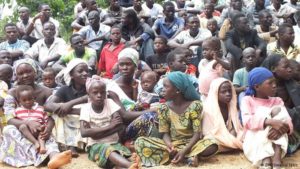Refugees make headlines, IDPs don’t
They don’t get the publicity afforded refugees perhaps because they are not forced to flee their home countries and seek refuge abroad, but internally displaced people (IDPs) outnumber international refugees almost two to one.
Conflict, violence and natural disasters forced more than 31 million people to leave home and settle elsewhere within their countries last year, the equivalent of one person every second.
But while the number of people uprooted internally by conflict soars, they have been largely ignored by the international community, according to a new report.
Norwegian Refugee Council’s Internal Displacement Monitoring Centre (IDMC) found last year, an estimated 6.9 million people were forced to leave their homes as a result of conflict and violence.
 Worst affected was the Democratic Republic of the Congo, where 922,000 were displaced, a 50 per cent rise on the previous year. Close behind was Syria (824,000), followed by Iraq (659,000), Afghanistan (653,000), Nigeria (501,000) and Yemen (478,000).
Worst affected was the Democratic Republic of the Congo, where 922,000 were displaced, a 50 per cent rise on the previous year. Close behind was Syria (824,000), followed by Iraq (659,000), Afghanistan (653,000), Nigeria (501,000) and Yemen (478,000).
The IDMC’s ‘2017 Global Report on Internal Displacement’ said disasters such as floods, storms and wildfires had an even greater effect, displacing 24.2 million people, more than three times the number uprooted by conflict.
This trend was at its most acute in East Asia and the Pacific. In China, 7.4 million were forced from their homes, with 5.9 million affected in the Philippines and a further 2.4 million in India. Floods accounted for half of all people displaced by disasters.
The report said 6.9 million people were internally displaced by conflict and violence in 2016. The total number of IDPs displaced by violence or conflict is 40.3 million, double the number from the year 2000.
By contrast, there were just 16.5 million refugees as of mid-2016 according to the United Nations Refugee Agency.
The report says low and middle income countries bear the brunt of internal displacement with the majority of displacements in 2016 taking place in high-risk environments with low coping capacity, high levels of socio-economic vulnerability ad high exposure to natural and man-made hazards.
IDMC Director Alexandra Bilak said that while resources had rightly been devoted to the refugee crisis, scant attention had been paid to people forced to resettle.
“Not including internal displacement as an integral part of that entire displacement and migration picture is very short sighted, because by looking only at the point of arrival and not considering where those journeys started, inevitably you’re missing part of the picture,” Ms Bilak said.
“If you redirect attention to the countries of origin and to really understanding the driving forces of these movements it would be a much more strategic approach and investment,” she said.
In some cases, a complex mix of conflict and disaster has forced communities from their homes, the report said.
In May last year, the UN proposed that governments commit to reducing the number of internally displaced people by at least 50 per cent by 2030. The report warned this is little more than an aspiration.
Last year, more aid was spent on refugee resettlement within donor nations than in the countries where displacement crises originated.
Laurie Nowell
AMES Australia Senior Journalist












